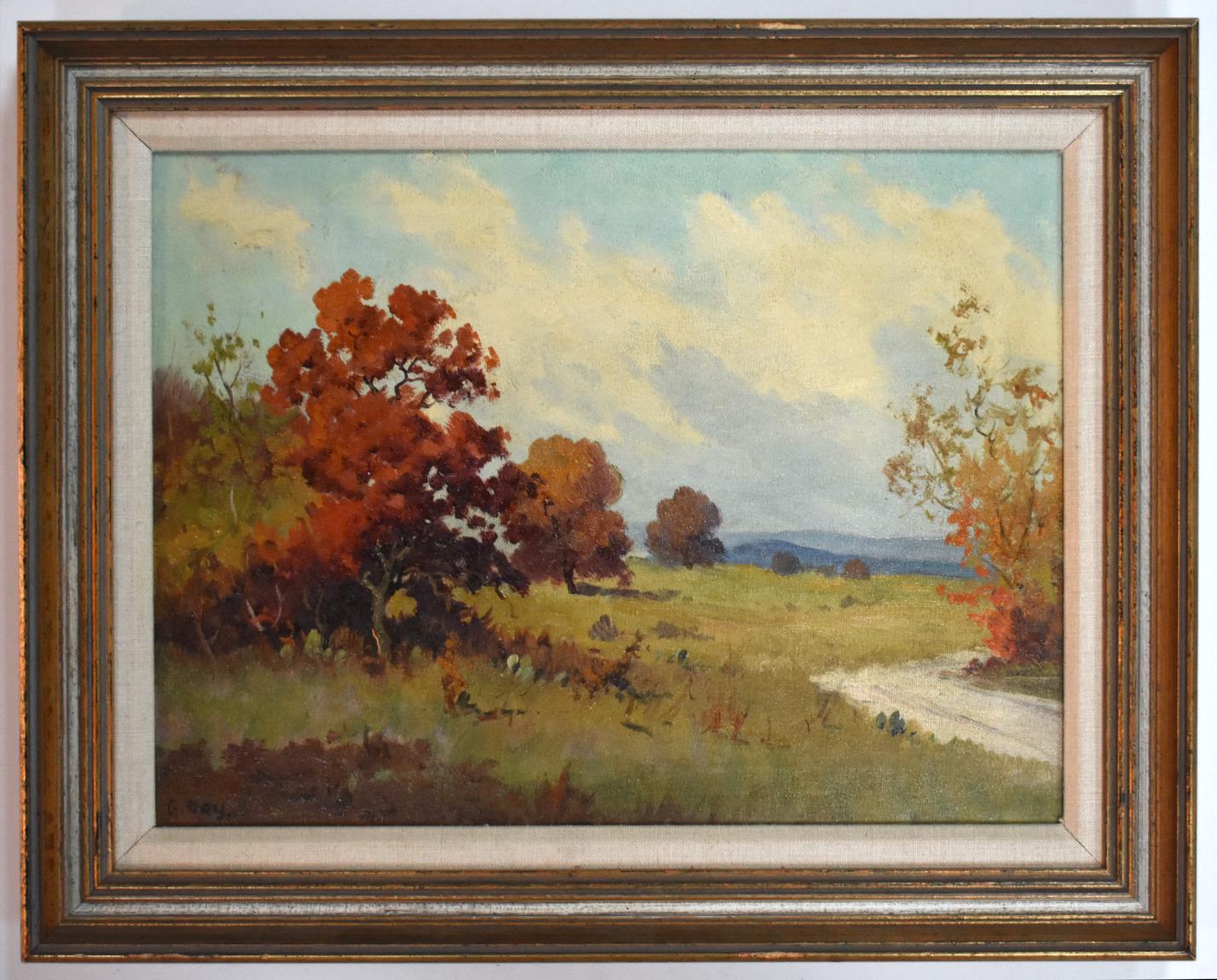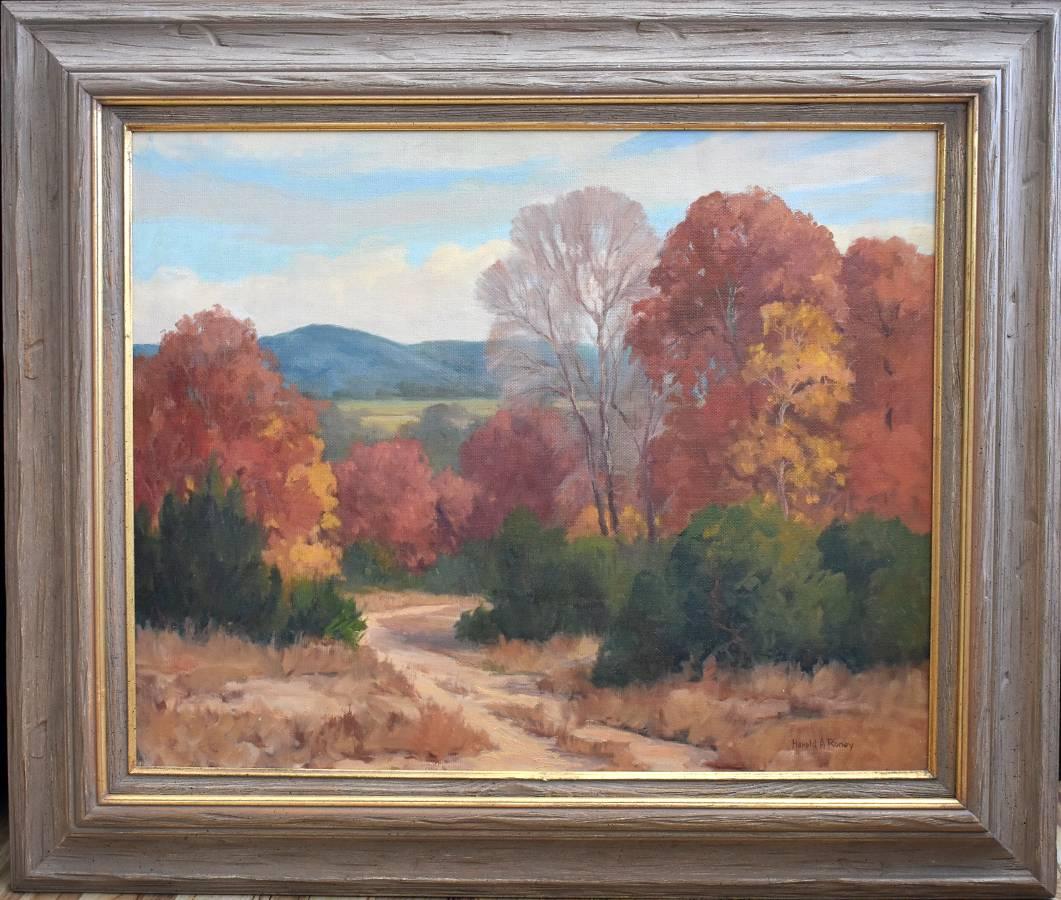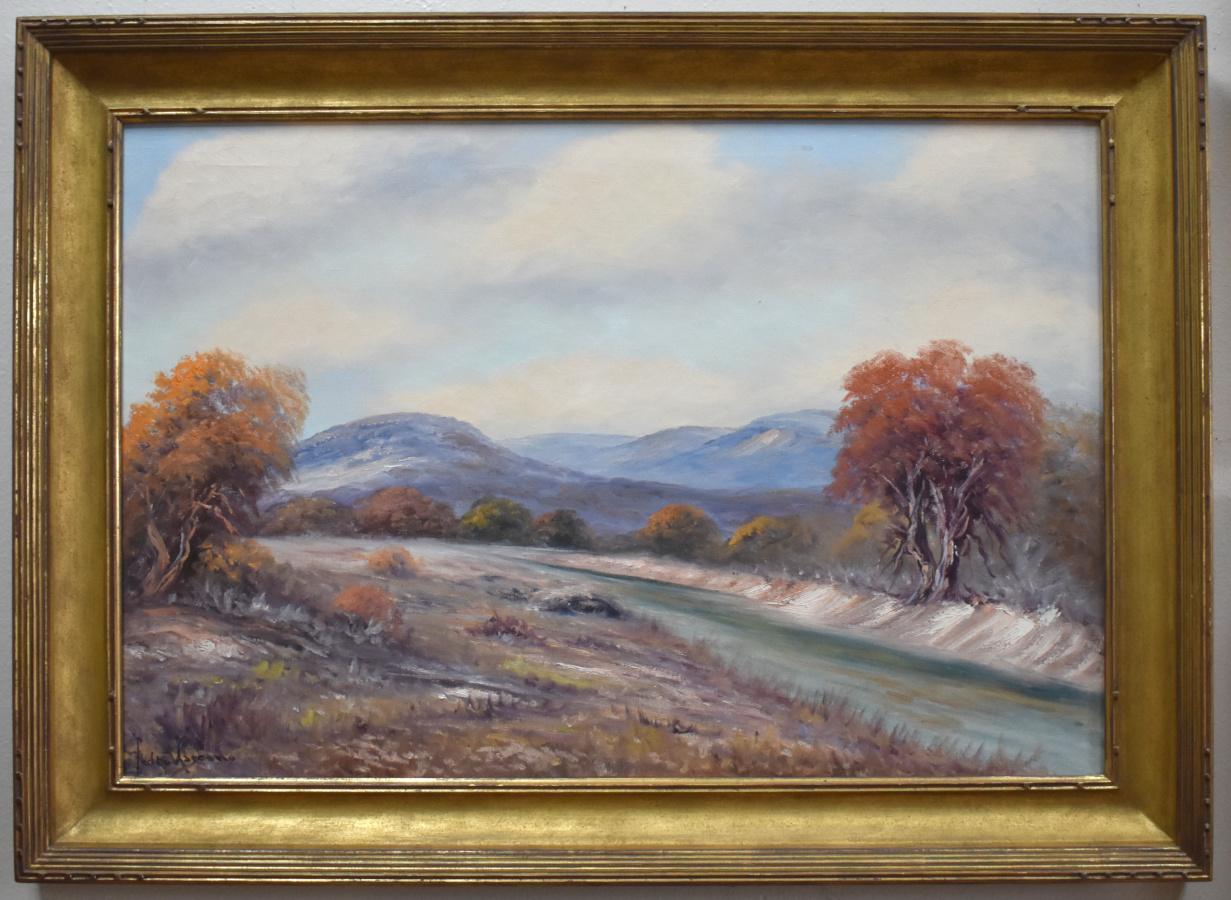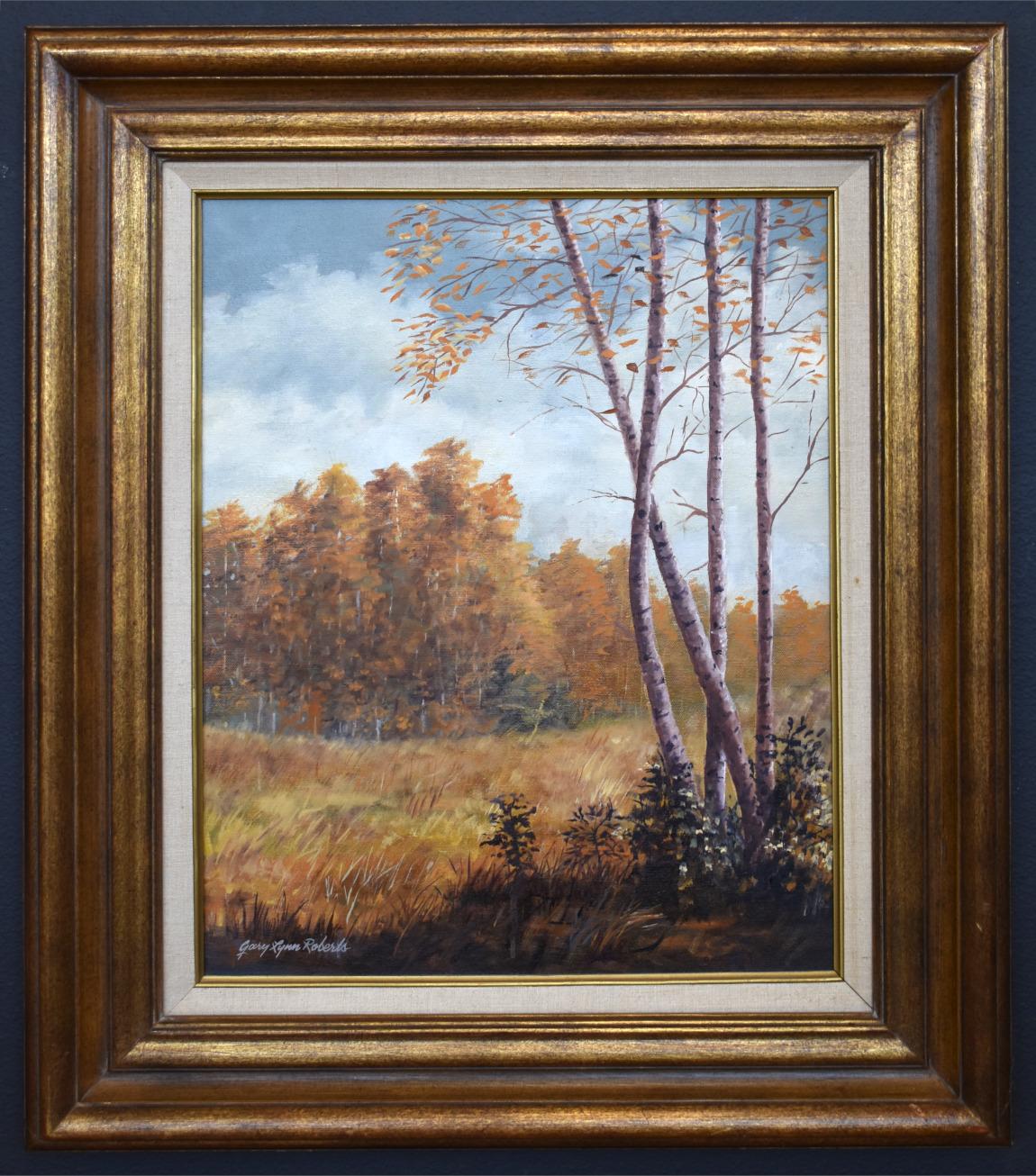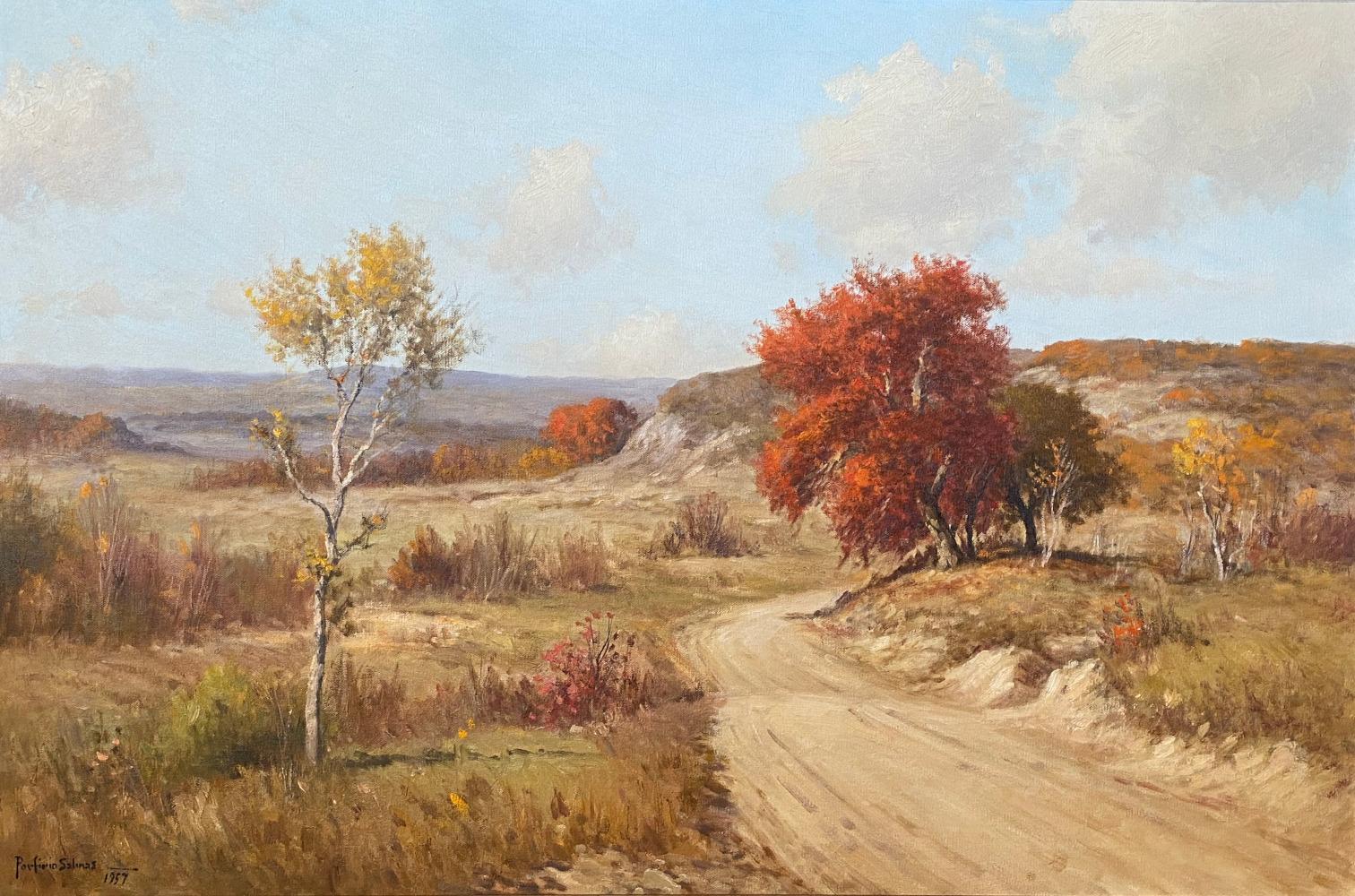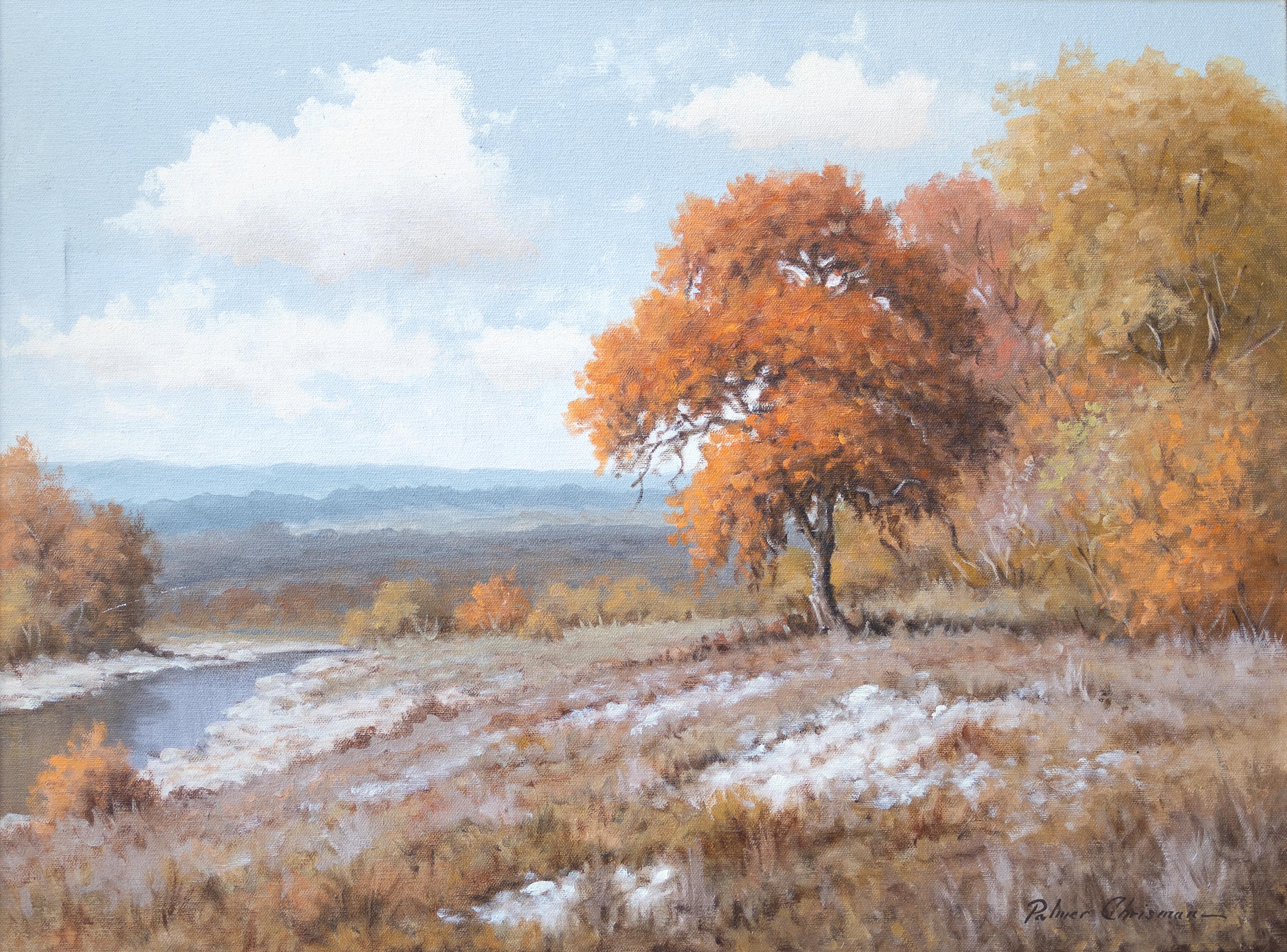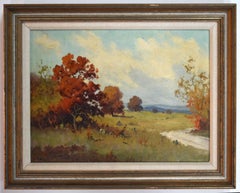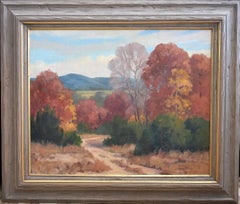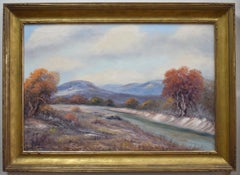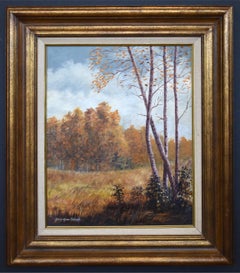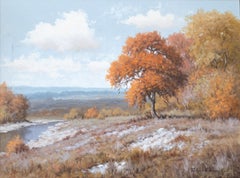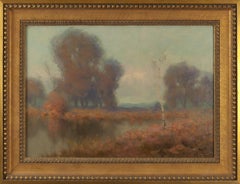Items Similar to "TEXAS AUTUMN" TEXAS HILL COUNTRY ROBERT WOOD
Want more images or videos?
Request additional images or videos from the seller
1 of 7
Robert W. Wood"TEXAS AUTUMN" TEXAS HILL COUNTRY ROBERT WOODCirca 1960s
Circa 1960s
$16,800
£12,923.68
€15,000.72
CA$23,692.01
A$26,539.04
CHF 13,939.26
MX$322,706.16
NOK 176,516.57
SEK 167,561.69
DKK 111,956.15
About the Item
Robert Wood (G. Day)
(1889 -1979)
San Antonio Artist
Image Size: 24 x 36
Frame Size: 34 x 46
Medium: Oil on Canvas
"Texas Autumn"
Biography
Robert Wood (G. Day) (1889 -1979)
A painter of realistic landscapes reflecting a vanishing wilderness in America, Robert Wood (not to be confused with Robert E. Wood) is reportedly one of the most mass-produced artists in the United States. His painting became so popular he was unable to meet all of the demands, and many of his works were reproduced in lithographs and mass distributed as prints, place mats, and wall murals by companies including Sears, Roebuck. He was born in Sandgate, Kent on the south coast of England near Dover, the son of W.L. Wood, a famous home and church painter who recognized and supported his son's talent. In fact, he forced his son to paint by keeping him inside to paint rather than playing with his friends. At age 12, Wood entered the South Kensington School of Art. As a youth, he came to the United States in 1910, having served in the Royal Army, and he never returned to England. He traveled extensively all over the United States, especially in the West, often in freight cars, and also painted in Mexico and Canada. His itinerant existence took him to Illinois where he worked as a farmhand, to Pensacola, Florida where he married, briefly in Ohio, Seattle, Washington, and Portland, Oregon. In 1912, he was in Los Angeles, and In the late 1920s and early 1930s, in San Antonio, Texas, where he lived and in 1928 exhibited in the "Texas Wildflower Competition." From San Antonio, he gained a national reputation for his strong colored, dramatic paintings. Some of that prestige has been credited to his association with Jose Arpa, prominent Texas artist. Wood also gave art lessons, and one of his students was Porfirio Salinas. During this period, Wood sometimes signed his paintings G. Day or Trebor, which is Robert spelled backwards. In 1941 he went to California and painted numerous desert and mountain landscapes and coastal scenes. He lived in Carmel for seven years, and then moved to Woodstock, New York, but he soon returned to California, settling first in Laguna Beach, then San Diego, and finally in the High Sierras, where he and his wife built a home and studio near Bishop and lived until his death in 1979. Robert Wood was born March 4, 1889 in Sandgate, England, a small town on the Kentish coast not far from the white cliffs of Dover. His father, W. J. Wood was a successful painter who recognized Robert's unusual talent. At the age of twelve, his father enrolled Wood in art school in the small town of Folkestone. He then attended the South Kensington School of Art. While attending art school, Wood won four first awards and three second awards, one each year, a record. In 1910 after service in the Royal Army, nineteen-year-old Wood and his friend, Claude Waters, immigrated to America. Initially, he settled in Illinois and worked as a hired hand on a farm belonging to Water's uncle. He would then strike out on his own, living the life of an itinerant painter. Wood traveled as a hobo, hopping freight trains and selling or bartering small paintings to support him along the way. When times were hard, he worked at whatever job was available. In this manner, he saw most of the United States and fell in love with rural America. By 1912, Wood visited Los Angeles for the first time, arriving on the day of the Titanic tragedy. Later that year, he had met, courted and married young Eyssel Del Wagoner in Florida. The couple moved to Ohio where a daughter, Florence, was born. During World War I, the family moved to Seattle where a son, John Robert Wood, was born in 1919. In the early 1920's, the young Wood family was almost constantly on the move. They stayed for short periods in Kansas, Missouri, California and for a longer time in Portland, Oregon, where Wood's friend Claude Waters had settled. Wood's seemingly endless wanderings disrupted his family life and delayed his development as a painter. However, through his travels he developed an appreciation for the American landscape that would inspire him for the rest of his career. Although aware of the current movement away from traditional realism in American art, he elected to travel that solitary path and remain true to his own vision of America's grandeur and beauty poetically translated through his landscape and seascape paintings. In 1923, the Wood family discovered the beautiful city of San Antonio, Texas and it was there that he and his family would finally settle. He studied briefly at the San Antonio Art School with Spanish colorist Jose Arpa y Perea (1860-1952), who had arrived in San Antonio that same year. In the latter part of the 1920’s, Jose Arpa’s influence quickly became evident. Wood after several years of experimentation was becoming a fine easel painter, capable of great subtlety with a new mature original style. Like Texas painters Robert Onderdonk (1853-1917) and his son Julian Onderdonk (1882-1922), Robert Wood concentrated on the distinctive Texas landscape with its Red Oak trees and wildflowers that covered the hill country landscape. He developed a reputation for his scenes of Blue Bluebonnets, the state flower. In the spring, the Texas prairie is covered with wildflowers, especially in the hill country surrounding San Antonio and Austin. Wood incorporated native stone barns and rough wood farm houses that added authenticity and romance to his compositions. In 1925, Wood was divorced from his wife. In 1932, he moved to the famous scenic loop on San Antonio's outskirts. While still living in Texas, he took extensive western sketching trips that brought him to California. It is evident that his 1930’s California and Texas works started to show his awareness of the then popular California Plein-Air movement. These more mature works are distinguished by a fine sense of detail reminiscent of late-19th-century American landscape painters laced with the colorful influence of American and French impressionism. With paintings being shipped to dealers across the continent, Wood’s reputation with collectors was growing nationally. It should be noted that from 1924 and 1940 Robert Wood also signed his paintings G. Day (Good Day) and Trebor (Robert backwards). He only used these signatures during these years (1924- 1940) and there is conflicting information as to why. In 1941 after seventeen years in Texas, Robert Wood and his second wife Tula, who he had met in San Antonio, moved to the coastal town of Laguna Beach, California. Laguna had been an artist colony since early in the century and it was the birthplace for California Plein-Air School, which was still active. While in Laguna, he developed a following for both his landscapes and marine paintings. Wood's paintings of the California coast remained a significant part of his oeuvre. Living in Laguna for seven years, Robert Wood became an active member of the Laguna Art Association and an exhibitor at the annual Laguna Festival of the Arts. After the War in 1948, the Woods moved east and bought a home in Woodstock, New York, which he had visited in the 1930’s. It was a popular artist colony located in the Catskills Mountains. He purchased a studio hidden deep in the Wood Stock forest where Maples and Elms, as well as a quiet brook surrounded his small rustic studio. He found inspiration from the bold autumn colors of the forest, the Catskill Mountains covered in pillows of snow and the blossoming fruit trees of spring. During this period, he made sketching trips to New Hampshire, Vermont and along the Maine coast. Although included in his eastern subjects, these Vermont, New Hampshire and Maine subjects are rare when compared to the hundreds of paintings done while in Woodstock. The public was captivated with Roberts Wood’s seasonal Woodstock paintings. He began working with an inexpensive print publishing house (possibly Donald Art Publishing Co.) to reproduce several of his paintings. The reproductions were an immediate success. October Morn, which was his most successful print, sold more than one million copies in less than two years. These inexpensive paper reproductions made Robert Wood one of America's most famous landscape painters. After a few years in New York, Robert and Tula moved back to Laguna Beach. 1952 and 1953 were tumultuous years for Robert Wood. He and Tula became increasingly estranged and they were divorced in 1952. The following year, Wood was hit by a car on Pacific Coast Highway and nearly died. His friend and amateur artist Caryl Price helped him around the house during his recovery and the two were soon married. He had instructed Caryl in painting and he would take her on sketching trips all throughout the west. During the 1950's, a combination of the popularity of Robert Wood's paintings and his print royalties eventually made him a comfortable living. It was during this period that Grand Tetons became a favorite subject. Although Robert Wood painted extensively in the Colorado Rockies in the 1930s and 1940s, he did not paint the Tetons until the late 1950s. By the early 1960s, the Tetons and the California coast made up a significant percentage of his artistic production. Wood would continue to paint his popular Texas landscapes but his style had changed. Works from this period are more broadly painted with a more chromatic palette, which was considerably different than those from the 1930s and 1940s. In the 1960's, Robert Wood found great success and his paintings brought higher prices, some selling in excess of five thousand dollars. At the age of eighty, the American Express Company commissioned him to paint a series of six works to be reproduced as limited edition serigraphs for their Cardholders. Each print depicted one of the National Parks, subjects that were well known to Wood. Around 1964, Robert and Caryl Wood moved to San Diego. They had purchased a wonderful Victorian house that Caryl wanted to restore. After several years in San Diego, they finally moved back to Bishop and the Sierras. Wood remained active and he continued to paint until just prior to his death in the spring of 1979, just weeks before his 90th birthday. Although Robert Wood shunned publicity and was modest about his accomplishments, he had millions of admirers who mourn his passing. There are thousands of artists in this country who learned a great deal by studying his work, his reproductions and through the art instruction books he authored for Walter Foster publishing.
- Creator:Robert W. Wood (1889 - 1979, American)
- Creation Year:Circa 1960s
- Dimensions:Height: 24 in (60.96 cm)Width: 36 in (91.44 cm)Depth: 3 in (7.62 cm)
- More Editions & Sizes:Image Size: 24 x 36 Frame Size: 34 x 46Price: $16,800
- Medium:
- Movement & Style:
- Period:
- Framing:Frame IncludedFraming Options Available
- Condition:Please visit my storefront for more vintage and mid-century artwork.
- Gallery Location:San Antonio, TX
- Reference Number:1stDibs: LU769316318462
About the Seller
5.0
Vetted Professional Seller
Every seller passes strict standards for authenticity and reliability
Established in 1974
1stDibs seller since 2017
99 sales on 1stDibs
Typical response time: 1 hour
- ShippingRetrieving quote...Shipping from: San Antonio, TX
- Return Policy
Authenticity Guarantee
In the unlikely event there’s an issue with an item’s authenticity, contact us within 1 year for a full refund. DetailsMoney-Back Guarantee
If your item is not as described, is damaged in transit, or does not arrive, contact us within 7 days for a full refund. Details24-Hour Cancellation
You have a 24-hour grace period in which to reconsider your purchase, with no questions asked.Vetted Professional Sellers
Our world-class sellers must adhere to strict standards for service and quality, maintaining the integrity of our listings.Price-Match Guarantee
If you find that a seller listed the same item for a lower price elsewhere, we’ll match it.Trusted Global Delivery
Our best-in-class carrier network provides specialized shipping options worldwide, including custom delivery.More From This Seller
View All"AUTUMN PATH" TEXAS HILL COUNTRY RARE G. DAY SIGNATURE
By Robert W. Wood
Located in San Antonio, TX
Robert Wood (G. Day)
(1889 -1979)
San Antonio Artist
Size: 12 x 16
Frame: 16 x 20
Medium: Oil
"Autumn Path"
Biography
Robert Wood (G. Day) (1889 -1979)
A painter of realistic landsca...
Category
20th Century Impressionist Landscape Paintings
Materials
Oil
"Texas Hill Country Fall" Fall Colos orange, yellow, etc.
By Harold Roney
Located in San Antonio, TX
Harold Roney Fall colors. Oranges, Yellows, Reds, etc.
(1899 - 1986)
San Antonio, Boerne Artist
Image Size: 26 x 32
Frame Size: 34 x 40
Medium: Oil
Texas Hill Country in Fall
Biogr...
Category
1950s Impressionist Landscape Paintings
"HILL COUNTRY CREEK" TEXAS AUTUMN FRAMED 30.5 X 42.5
By Pedro Lazcano
Located in San Antonio, TX
Pedro Lazcano
(1909-1970)
San Antonio Artist
Image Size: 24 x 36
Frame Size: 30.5 x 42.5
Medium: Oil
"Hill Country Creek"
Pedro Lazcano (1909-1970)
I was always curious about Pedro L...
Category
1960s Impressionist Landscape Paintings
Materials
Oil
"FALL LANDSCAPE" HILL COUNTRY
By Gary Lynn Roberts
Located in San Antonio, TX
Gary Lynn Roberts
(Born 1953)
Texas Artist
Image Size: 20 x 16
Frame Size: 28.5 x 24.5
Medium: Oil
Dated 1973
"Fall Landscape"
Gary Lynn Roberts (Born 1953)
...
Category
1970s Impressionist Landscape Paintings
Materials
Oil
"HILL COUNTRY RANCH ROAD" TEXAS HILL COUNTRY AUTUMN LARGE SIZE FRAMED 37 X 49
By Porfirio Salinas
Located in San Antonio, TX
Porfirio Salinas
(1910-1973)
San Antonio Artist
Image Size: 24 x 36
Frame Size: 37 x 49
Medium: Oil
Dated 1957
"Hill Country Ranch Road"
Porfirio Salinas was a self-taught artist who painted landscapes of Central Texas with an emphasis on the vast bluebonnet fields...
Category
1950s Impressionist Landscape Paintings
Materials
Oil
"TEXAS SUMMER" HILL COUNTRY CIRCA 1930'S 1872-1957 COMFORT ARTIST
Located in San Antonio, TX
P. L. Hohnstedt (Peter Lanz)
(1872 - 1957)
San Antonio, Comfort Artist
Image Size: 12 x 16
Medium: Oil
Circa 1930s
"Texas Summer" Hill Country
Biography
P. L. Hohnstedt (Peter Lanz) ...
Category
1930s Impressionist Landscape Paintings
Materials
Oil
You May Also Like
Texas Hill Country Fall Landscape
Located in Austin, TX
This warm fall landscape scene by Palmer Chrisman (1913-1984) depicts a hillside view of a tree with orange leaves and a creek with blue hills in the b...
Category
20th Century Naturalistic Landscape Paintings
Materials
Canvas, Oil
California Landscape in Autumn
Located in San Francisco, CA
This artwork "California Landscape in Autumn" c.1980, is an oil painting on canvas by noted California artist Bill Shaddix, b.1930. It is signed at the lo...
Category
Late 20th Century American Impressionist Landscape Paintings
Materials
Oil
Idealistic Fall Texas Landscape
By Dollie Nabinger
Located in Houston, TX
Pastel colored landscape of Texas in the fall. Signed by the artist in the bottom left hand corner. Framed in an elegant gold frame.
Artist Biography: Landscape artist Dollie Spidle Nabinger was born in Commerce, Texas, raised in Victoria, Texas. Even as a young girl Dollie wanted to be an artist. Her parents supported her from the very start, enrolling her in a Catholic school. Her father personally stretched her first canvases. Dollie credited that loving support for her eventual success as an artist. When Dollie was 13, her talent was already evident. J.F. McCan, a well-known Victoria artist, accepted her as his apprentice. She studied with him for seven years. Next she was off to the Art Students' League in New York for two years' instruction; later, in San Antonio, she studied with Jose Arpa and Harry Anthony DeYoung. In 1955 she spent a summer at the Academie Julian in Paris, France. Dollie was married to Jack E. Nabinger, who handmade and carved many of her frames. They retired in Fredericksburg Texas...
Category
1950s Realist Landscape Paintings
Materials
Oil
Autumn Landscape
By Royal Milleson
Located in Fairlawn, OH
Autumn Landscape
Oil on relined canvas, c. 1915
Signed lower right corner: "Royal H. Milleson"
Condition: Excellent
Canvas size: 14 1/2 x 20 3/8 inches
Frame size: 19-1/4 x 25-1/4 x 2-1/2 inches
Clearly among the artist's finest paintings!
Provenance: Private Collection, Greencastle, Indiana
Ray H. French Collection (1919-2000)
Martha A. French Trust
Royal Hill Milleson...
Category
1910s American Impressionist Landscape Paintings
Materials
Oil
Autumn Landscape Painting Signed by W.E. Beatty
Located in New York, NY
W.E. Beatty
Untitled (Autumn Landscape), c. 20th century
Oil on canvas
16 x 20 in.
Framed: 22 1/2 x 26 1/2 in.
Signed lower right: W E BEATTY
Category
20th Century American Impressionist Landscape Paintings
Materials
Oil
American Impressionist Painting Woodstock Artist John F Carlson Autumn Splendor
Located in Chesterfield, NJ
Autumn Splendour
oil on canvas
10 x 8 image size, 16 x 14 framed
The painting is in excellent condition in a gilded Impressionist frame showing Carlson's mastery of light and technique. Carlson uses subtle cool vs warm strokes of color and some texture in the foreground to help create a sense of depth in this beautiful little autumn painting.
Comes unsigned but with estate stamp and Vose Galleries label verso. Also a Swains Art Store label from Plainfield, NJ where his wife Margaret Carlson was from. See below from Natl' Academy of Art bio.
John Fabian Carlson (May 5, 1875 – May 19, 1947) was a Swedish-born American Impressionist painter.
from Wikipedia
Background
John Fabian Carlson was born in Kolsebo in Västervik Municipality, Kalmar County, in Småland, Sweden. The Carlson family immigrated to the United States in 1884, making their home in Buffalo, New York. Carlson attended evening art classes at the Art Students League of Buffalo, New York. There Carlson received instruction from Lucius Wolcott Hitchcock, a former pupil at the Académie Colarossi in Paris and the Art Students League of New York.
Carlson won a scholarship in 1903 or 1904 to study with Lovell Birge...
Category
21st Century and Contemporary Impressionist Landscape Paintings
Materials
Oil
More Ways To Browse
Texas Revolution Or Alamo Paintings
Old Wood Art
Vintage Wood Flowers
Spanish Frame Wood
Wood Fruit
Ship Old Wood
Robert Stone
Robert Daughters
Hand Painted Flowers On Wood
Used Barn Wood
Colorful Wood Wall Art
Wood Car
Robert Weeks
Oil Painting On Wood 1940
Dior Car
Landscape Serigraphs
Texas Lithograph
Romance Was Born
